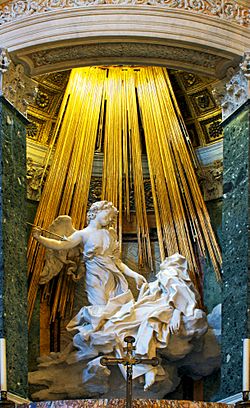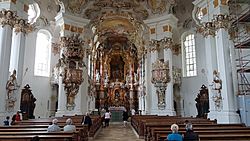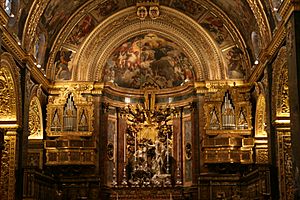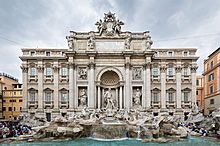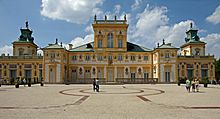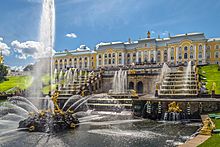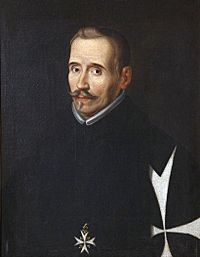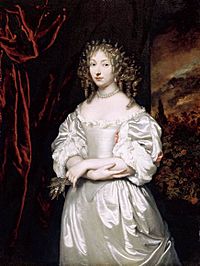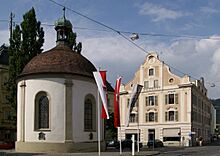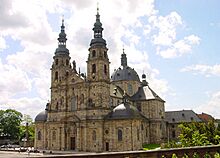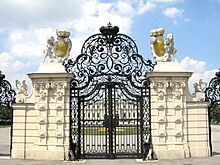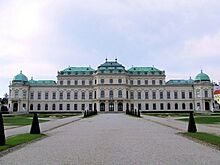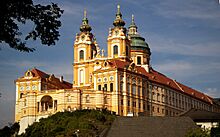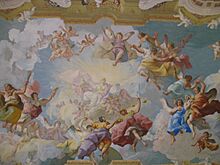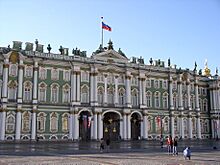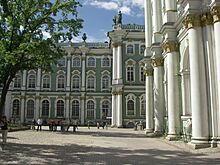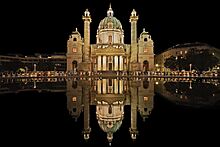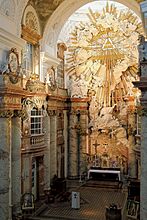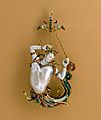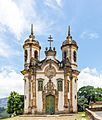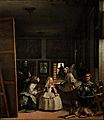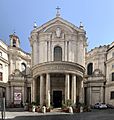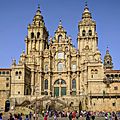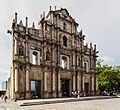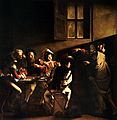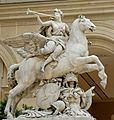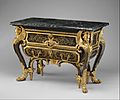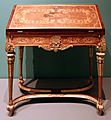Baroque facts for kids
|
Top: The Ecstasy of Saint Teresa by Bernini (1651); Bottom: The Wieskirche in Bavaria (1754)
|
|
| Years active | 17th–18th centuries |
|---|---|
Baroque is a special style of art. It was popular from about 1575 to 1770. This was between the Renaissance and Neoclassicism art styles. During this time, many monarchs (kings and queens) in Europe had absolute power. Baroque art often looks very fancy and has lots of decorations.
This art style started in Italy. Then, it spread to countries in Europe that were mostly Catholic. Later, it also reached Protestant countries.
The word Baroque comes from Portuguese. In Portuguese, barocco means something like strange. It was first used to describe pearls that were not perfectly round. In France, people used it for art that didn't follow the usual rules. The Baroque period lasted from the 1600s to the 1750s. Famous music makers from this time include Alessandro Scarlatti and Handel.
Contents
Periods of Baroque Art
The Baroque era is often split into three main parts:
- Early Baroque: Around 1590 to 1625
- High Baroque: Around 1625 to 1660
- Late Baroque: Around 1660 to 1725
Sometimes, the "Late Baroque" period is also called Rococo. Rococo is a lighter, more playful style that came after Baroque.
Baroque Art Styles
Painting
Baroque paintings often show "strong lighting, deep feelings, and a sense of freedom." They didn't always show everyday life. Instead, they often made the church and kings look very grand and important.
Many different kinds of Baroque painting came from Italy. Some famous painters were Caravaggio and Peter Paul Rubens. In Spain, Diego Velázquez was a very important Baroque painter.
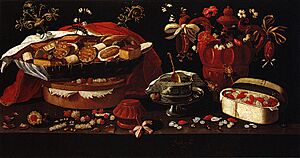
Another well-known Baroque artwork is Bernini's Saint Theresa in Ecstasy. This piece combines architecture, sculpture, and even light to tell a story.
Over time, the Baroque painting style slowly changed into the more decorative Rococo style.
Sculpture
Baroque sculptures often feature groups of figures. These sculptures show a lot of movement and energy. The figures might twist around a central point or reach out into the space around them.
For the first time, Baroque sculptures often looked good from many different angles. Sculptors also added special effects. For example, they might use hidden lights or water fountains with their sculptures. Aleijadinho from Brazil was a great Baroque sculptor. His best work is the statues at the Santuário de Bom Jesus de Matosinhos. The soapstone statues of Old Testament prophets there are very famous.
The buildings, sculptures, and fountains by Bernini (1598–1680) truly show the Baroque style. Bernini was definitely the most important sculptor of the Baroque period.
Bernini's Ecstasy of Saint Teresa
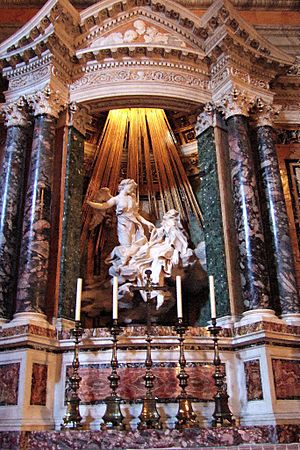
A great example of Bernini's Baroque work is his Ecstasy of Saint Teresa. He made this from 1645 to 1652 for the Cornaro Chapel in the church of Santa Maria della Vittoria in Rome. Bernini designed the whole chapel for the Cornaro family.
Saint Teresa, the main part of the chapel, is a soft white marble statue. It is surrounded by colorful marble and architectural details. A hidden window lights the statue from above. Sculpted figures of the Cornaro family are placed in opera-like boxes on the chapel walls. They look like they are leaning forward to watch the saint's mystical experience. This setup makes you feel like you are watching a play.
Baroque Architecture
Baroque buildings focused on big, bold shapes. They used many colonnades (rows of columns) and large domes. They also played with light and shadow (called chiaroscuro) and used colors like a painter would.
Inside, Baroque buildings often had huge staircases. These staircases were grander than anything seen before. Another new idea was the "state apartment." This was a series of rooms that became fancier and fancier. They usually ended in a special room for the king or queen. Many rich homes copied these grand stairs and state rooms.
Baroque architecture became very popular in central Germany, Austria, and Russia. Famous examples include Ludwigsburg Palace and Zwinger, Dresden in Germany, and Peterhof in Russia.
In England, important Baroque buildings were designed by Sir Christopher Wren, Sir John Vanbrugh, and Nicholas Hawksmoor. This was from about 1660 to 1725.
Many Baroque buildings and city designs can be found across Europe and in Latin America. Cities from this time often had main roads that spread out from central squares. This idea came from Baroque garden designs.
In Sicily, Baroque architecture developed its own unique look. You can see this in towns like Noto, Ragusa, and Acireale (with its "Basilica di San Sebastiano").
Another great example is the Cathedral of Morelia in Michoacán, Mexico. It was built in the 17th century and is one of many Baroque cathedrals in Mexico. Baroque churches built during the Spanish rule are also found in other former Spanish colonies.
- Architecture
-
Trevi Fountain in Rome
-
Wilanów Palace in Warsaw
Baroque Theatre
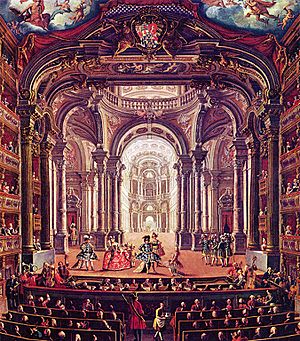
Theatre really grew during the Baroque era. It became a "multimedia" experience, using many different elements. A lot of the stage technology used in plays today was actually invented back then! A stage could change from a lovely garden to a palace inside in just a few seconds. The audience only saw the main action, while all the ropes and pulleys were hidden.
This was a time when "gods" could actually fly down from the sky to save the hero. This happened even in the most dangerous or silly situations.
The idea of "Theatrum Mundi" (the world is a stage) also became popular.
Theatre in England
The influence of the Renaissance came late to England. There was an 18-year period when London theatres were closed. This was during the English Civil War and English Commonwealth. They reopened when Charles II became king again in 1660.
Theatre in Germany
German theatre in the 17th century didn't have many big new ideas. The most famous writer was Andreas Gryphius. He was inspired by Dutch and French playwrights. There was also Johannes Velten. He mixed English comedy with classic French theatre. His traveling acting group was very important in the 17th century.
Theatre in Spain
In Spain, Baroque theatre had a strong Catholic and traditional feel. It followed Italian writing styles from the Renaissance.
Baroque Literature
The most important English writers of the 17th century were William Shakespeare, who wrote plays, and John Milton, who wrote long poems.
In France, this was a brilliant time known as the Grand Siècle (Great Century). Molière, Pierre Corneille, and Jean Racine wrote famous plays. Jean de La Fontaine and Charles Perrault wrote fables (short stories with a moral).
The Baroque era was the greatest time in Spanish literature. It's called the Siglo de Oro (Golden Age). Famous playwrights included Pedro Calderon de la Barca and Lope de Vega. Juana Inés de la Cruz was a well-known poet. And Miguel de Cervantes is seen as the first novelist, famous for Don Quixote.
Baroque Music
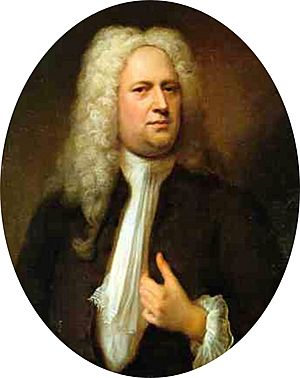

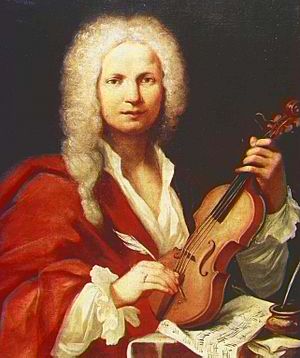
The word Baroque is also used for music from this time. The music period overlaps with the art period but often goes a bit later.
Many musical forms were created then. These include the concerto (for a solo instrument with orchestra) and sinfonia (a type of symphony). Forms like the sonata, cantata, and oratorio also became very popular. Opera was born from experiments by the Florentine Camerata. They tried to bring back the theatre styles of Ancient Greece. A key technique in Baroque music was the use of a ground bass. This is a repeated bass line. Dido's Lament by Henry Purcell is a famous example.
Baroque Composers and Music Examples
- Giovanni Gabrieli (c. 1554–1612) – Sonata pian' e forte (1597)
- Claudio Monteverdi (1567–1643) – L'Orfeo (1610)
- Heinrich Schütz (1585–1672) – Musikalische Exequien (1629)
- Jean-Baptiste Lully (1632–1687) – Armide (1686)
- Johann Pachelbel (1653–1706) – Canon in D (1680)
- Arcangelo Corelli (1653–1713) – 12 concerti grossi, Op. 6 (1714)
- Henry Purcell (1659–1695) – Dido and Aeneas (1688)
- Alessandro Scarlatti (1660–1725) – L'honestà negli amori (1680)
- Antonio Vivaldi (1678–1741) – The Four Seasons (1723)
- George Frideric Handel (1685–1759) – Water Music (1717), Messiah (1741)
- Johann Sebastian Bach (1685–1750) – Brandenburg Concertos (1721), St Matthew Passion (1727)
Baroque Fashion
Baroque fashion started around 1650. Clothes were very decorative, big, and flashy. They often had fancy lace necklines, wide sleeves, and large hair or wigs.
This style was meant to show off wealth and high social status. So, people from lower classes usually did not wear this kind of fashion.
Related Pages
Gallery
- Architecture
-
Melk Abbey is a famous monastery in Austria.
-
The Winter Palace in St. Petersburg.
-
A detailed part of a fresco inside the Karlskirche.
Images for kids
-
A ceiling painting (Quadratura) in the Church of the Gesù in Rome, by Giovanni Battista Gaulli.
-
Las Meninas by Diego Velázquez, 1656. This famous painting is in the Museo del Prado in Madrid.
-
Set design for Andromedé by Pierre Corneille, 1650.
-
A theatre set design by Giacomo Torelli for the ballet Les Noces de Thétis.
-
Santa Maria della Salute in Venice, built from 1631–1687.
-
San Carlo alle Quattro Fontane in Rome, built from 1638–1677.
-
Fontana dei Quattro Fiumi (Fountain of Four Rivers) in Rome, by Gian Lorenzo Bernini.
-
St. Peter's Square in Vatican City, designed by Gian Lorenzo Bernini.
-
Palacio de San Telmo in Seville, Spain, built from 1682–1796.
-
The vestry of the Granada Charterhouse in Spain, 1727–1764.
-
The front of the Cathedral of Santiago de Compostela in Spain, 1738.
-
Inside the Church of Saint Nicholas in Prague, Czech Republic, 1703–1711.
-
Upper Belvedere in Vienna, 1717–1723.
-
The East front of the Louvre in Paris, 1665–1680.
-
Dôme des Invalides in Paris, 1677–1706.
-
The Hall of Mirrors at the Palace of Versailles, 1678-1684.
-
The Grand Staircase of the Sanctuary of Bom Jesus do Monte in Braga, Portugal, around 1784.
-
Peterhof Gardens in Saint Petersburg, Russia, 1746–1758.
-
Tsarskoe Selo in Pushkin, Russia, 1749–1756.
-
Cusco Cathedral in Cusco, Peru, built from 1559–1654.
-
Church of San Francisco Acatepec in San Andrés Cholula, Mexico, 17th–18th centuries.
-
Church of San Lorenzo de Carangas in Potosí, Bolivia, mid-16th century–around 1744.
-
Santo Domingo Church in Santiago, Chile, 1747–1808.
-
Church of Santa Prisca de Taxco in Taxco, Mexico, 1751–1758.
-
São Paulo in Diu, India, 1601.
-
Saint Augustine Church in Paoay, Luzon, Philippines, begun in 1694.
-
Pulpit inside the Basilica of Bom Jesus in Goa, India, 18th century.
-
Resurrection of Christ by Annibale Carracci, 1593.
-
The Calling of St Matthew by Caravaggio, around 1602–1604.
-
Self-portrait with Isabella Brant by Peter Paul Rubens, around 1609-1610.
-
The Night Watch by Rembrandt, 1642.
-
Vanitas Still Life by Maria van Oosterwijck, 1668.
-
Saint Veronica by Francesco Mochi, 1629–1639.
-
Ecstasy of Saint Teresa by Gian Lorenzo Bernini, 1647–1652.
-
The King's Fame Riding Pegasus by Antoine Coysevox, 1698-1702.
-
A cupboard by André Charles Boulle, around 1700.
-
Gardens at Vaux-le-Vicomte in France, 1657-1661.
See also
 In Spanish: Barroco para niños
In Spanish: Barroco para niños


